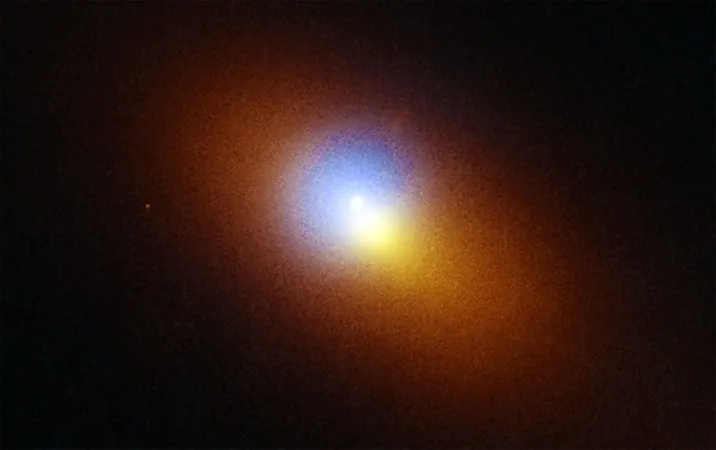
Astronomers Capture Stunning Footage of a Black Hole Devouring a Star
2025-05-13
Author: Ling
Imagine a scene straight out of a sci-fi thriller: astronomers have recently unveiled a jaw-dropping event where a supermassive black hole was filmed stalking and ultimately consuming a star. This spectacular cosmic drama unfolded 600 million light-years away from Earth, providing a rare glimpse into the life-and-death struggle that plays out in the depths of space.
The incident, known as a tidal disruption event (TDE), was spotted by advanced telescopes coordinated by scientists at the University of California, Berkeley. The stellar feast produced an intense burst of radiation, illuminating the black hole as it feasted on the unfortunate star.
An Unusual Discovery: Not Your Average Black Hole
What sets this discovery apart is the black hole's unconventional location. Usually nestled within the heart of a galaxy, this particular black hole is located approximately 2,600 light-years from the galactic center. Weighing in at around one million solar masses, it stands out not just for its mass but also for its rogue position—especially considering a bigger black hole, 100 million times the mass of the Sun, resides at the galaxy's core.
This groundbreaking observation marks the first time astronomers have witnessed a TDE occurring away from a galactic core, as approximately 100 previously known TDEs have all taken place with the black holes central to their galaxies.
A Cosmic Odd Couple
Within this galaxy, the larger black hole continues to aggressively accumulate gas and emit energy, branding it as an active galactic nucleus. In stark contrast, the smaller rogue black hole drifts aimlessly—though it could potentially spiral inwards over time, merging with its massive counterpart. For now, however, they exist separately, each marking a unique celestial footprint.
The Spectacle of Tidal Disruption Events
Tidal disruption events occur when a black hole’s immense gravitational forces stretch a star into thin, elongated strands in a process known as 'spaghettification.' The shredded remnants of the star ignite a brilliant glow, creating a visual spectacle that spans ultraviolet and visible light spectrums.
Yuhan Yao from UC Berkeley emphasized the significance, stating, 'This is the first time we've captured an offset TDE, opening the door to discovering a hidden population of wandering black holes with future sky surveys.' There's an entire population of elusive black holes that have gone unnoticed, waiting to be revealed.
An Initial Misinterpretation
The cosmic flare first caught astronomers' attention due to its brightness, indistinguishable from a supernova. However, follow-up analyses unraveled the truth. Observations revealed high temperatures and emissions of elements like hydrogen and carbon, solidifying the understanding that a black hole was feasting on a star.
Decoding the Black Hole’s Origin
The origins of this wandering black hole are still enveloped in mystery. One theory suggests it may have been ejected from its galaxy's core during a three-body interaction involving two other black holes. Alternatively, it might have roots in a smaller galaxy that merged with this one billions of years ago.
Erica Hammerstein of UC Berkeley, who examined the Hubble recordings, found no signs of a previous merger, suggesting more investigation is crucial to untangle this cosmic enigma.
What Lies Ahead?
The breathtaking event captured during AT2024tvd required a combination of specialized telescopes, and upcoming tools like the Vera C. Rubin Observatory and NASA's Nancy Grace Roman Space Telescope are poised to capture similar fleeting cosmic spectacles in the future. With advancement on the horizon, scientists are optimistic about uncovering more secrets of hidden black holes lurking in the vast universe.

 Brasil (PT)
Brasil (PT)
 Canada (EN)
Canada (EN)
 Chile (ES)
Chile (ES)
 Česko (CS)
Česko (CS)
 대한민국 (KO)
대한민국 (KO)
 España (ES)
España (ES)
 France (FR)
France (FR)
 Hong Kong (EN)
Hong Kong (EN)
 Italia (IT)
Italia (IT)
 日本 (JA)
日本 (JA)
 Magyarország (HU)
Magyarország (HU)
 Norge (NO)
Norge (NO)
 Polska (PL)
Polska (PL)
 Schweiz (DE)
Schweiz (DE)
 Singapore (EN)
Singapore (EN)
 Sverige (SV)
Sverige (SV)
 Suomi (FI)
Suomi (FI)
 Türkiye (TR)
Türkiye (TR)
 الإمارات العربية المتحدة (AR)
الإمارات العربية المتحدة (AR)